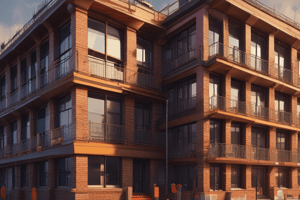Podcast
Questions and Answers
What is the fire resistance rating for roof deck and construction supporting the roof in Type I (fire resistive) construction?
What is the fire resistance rating for roof deck and construction supporting the roof in Type I (fire resistive) construction?
- 2-3 hours
- 4-5 hours
- 3-4 hours
- 1-2 hours (correct)
Which building classification is most commonly constructed using a protected steel frame or reinforced concrete?
Which building classification is most commonly constructed using a protected steel frame or reinforced concrete?
- Type IV - Heavy timber
- Type II - Noncombustible or protected noncombustible
- Type I - Fire Resistive (correct)
- Type III - Exterior protected (masonry)
What is the fire resistance rating for interior partitions enclosing stairwells and corridors in Type I (fire resistive) construction?
What is the fire resistance rating for interior partitions enclosing stairwells and corridors in Type I (fire resistive) construction?
- 3-4 hours
- 1-2 hours (correct)
- 2-3 hours
- 4-5 hours
Which material is inherently noncombustible with good thermal insulating properties?
Which material is inherently noncombustible with good thermal insulating properties?
Which type of construction permits limited use of combustible materials, including roof coverings and interior floor finishes?
Which type of construction permits limited use of combustible materials, including roof coverings and interior floor finishes?
What is the minimum nominal dimension for floor construction in Type IV (heavy timber) construction?
What is the minimum nominal dimension for floor construction in Type IV (heavy timber) construction?
In which type of construction are all major structural components permitted to be of combustible construction?
In which type of construction are all major structural components permitted to be of combustible construction?
What does fire resistance indicate?
What does fire resistance indicate?
Which test is the standard test for fire resistance?
Which test is the standard test for fire resistance?
What contributes to the calculation of the fire load?
What contributes to the calculation of the fire load?
What type of construction frequently uses exterior walls of masonry?
What type of construction frequently uses exterior walls of masonry?
What are the failure criteria for testing fire resistance specific to?
What are the failure criteria for testing fire resistance specific to?
What type of construction frequently uses exterior walls of masonry?
What type of construction frequently uses exterior walls of masonry?
What does the second digit in the NFPA 220 classification code represent?
What does the second digit in the NFPA 220 classification code represent?
What must be done when using unprotected steel in fire resistive designs?
What must be done when using unprotected steel in fire resistive designs?
What does the first digit in the NFPA 220 classification code represent?
What does the first digit in the NFPA 220 classification code represent?
In Type II-B construction, what is the characteristic that is most common?
In Type II-B construction, what is the characteristic that is most common?
What is a key distinction between Type III and Type IV construction?
What is a key distinction between Type III and Type IV construction?
What is a requirement for Type II-A construction regarding fire resistance rating of structural components?
What is a requirement for Type II-A construction regarding fire resistance rating of structural components?
What is a fundamental fire concern with type III construction?
What is a fundamental fire concern with type III construction?
Where are the combustible concealed spaces created in type III construction?
Where are the combustible concealed spaces created in type III construction?
What is mixed construction?
What is mixed construction?
Flashcards are hidden until you start studying
Study Notes
Building Construction and Fire Resistance
- Reinforced concrete can fail under an explosion or intense fire of long duration.
- Building codes permit limited use of combustible materials in type I construction, including roof coverings, interior floor finishes, and more.
- Type II construction allows for a wider range of materials than type I, including steel, concrete block, glass, and aluminum.
- Type III construction frequently uses exterior walls of masonry and concealed spaces must contain appropriate fire stops.
- Type IV (heavy timber) construction requires minimum nominal dimensions of 6 in. x 10 in. for floor construction.
- In Type V construction, all major structural components are permitted to be of combustible construction.
- Mixed construction occurs where a new structure is built onto an existing structure of a different construction type.
- The International Building Code contains 10 major occupancy classifications, such as Assembly, Business, Educational, and more.
- The fuel load contributes to the calculation of the fire load, the maximum amount of heat that can be released if all fuel is consumed.
- Fire resistance indicates the ability of a structural assembly to maintain its load-bearing capacity and structural integrity under fire conditions.
- Standard test for fire resistance is the ASTM E-119, also known as NFPA 251, conducted in Germany in 1884-86 and in the US in 1890 and 1896.
- Failure criteria for testing are specific to the specimen being tested and fire resistance ratings for test specimens are expressed in standard intervals such as 15 min, 30 min, 45 min, 1 hour, etc.
Studying That Suits You
Use AI to generate personalized quizzes and flashcards to suit your learning preferences.




